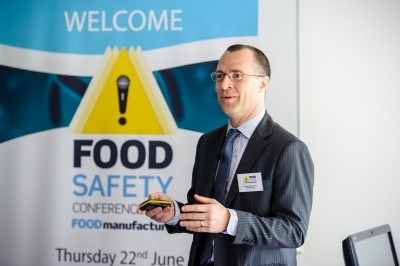Feature analysis
Food safety: why it’s all a state of mind

The individual building blocks that contribute to food safety have been well known for many years.
But a much more recent focus on food safety culture reflects a growing concern not only for what holds these different elements together but, more importantly, what stops non-compliance and food safety incidents from falling through the ‘gaps’.
Every year for the past five years, Campden BRI has compiled its Global Food Safety Training Survey.
This assesses, among other parameters, the priorities of those sourcing the training, whether via its own organisation, the British Retail Consortium (BRC) Global Standards or other providers.
According to Campden BRI head of training Bertrand Emond, there has been a consistent trend towards prioritising improved food safety culture as a training objective.
For the past couple of years, around 80% of respondents have identified this as the most important goal, ahead of ‘effective employee performance’ and ‘safe, wholesome product’, for example.
But why emphasise something as intangible as a ‘culture’ above other apparently more observable and measurable indicators?
Sterling Crew is vice president of the Institute of Food Science & Technology (IFST) and a regular speaker and consultant on the topics of food safety and hygiene.
“The concept of food safety culture is very new to business,” he argues. “It’s only now that awareness is growing of the essential role it plays in preventing outbreaks of foodborne disease.”
Nor is it only food manufacturers and training specialists who confirm the growing importance of food safety culture.
At the Chartered Institute of Environmental Health (CIEH), head of policy Tony Lewis – himself a former food inspector – says that conversations held during inspections will sometimes focus on the culture inside the factory, especially if the inspector has been visiting the site for some time.
“In fact, there is an argument that, going forward, focusing on culture can be a better way of managing an inspection and that it might lead to better levels of food safety and public protection,” he reports.
Emphasis on unannounced audits (back to top)
At Campden, which applies the assessment techniques of Joanne Taylor and fellow researchers in this area, Emond notes the link between improving food safety culture and the increasing emphasis on unannounced audits.
“Manufacturers that want to move to the next level need to be ready for audits at all times, whether under the BRC or from retailers,” he says.
The broad outline of food safety culture, what it is and where pitfalls lie, can be mapped out in the language of behavioural dynamics.
This includes the fairly self-explanatory ‘illusion of control’ and the ‘optimism bias’. The idea of ‘cognitive dissonance’ can be important, says Crew at the IFST, where priorities (such as safety and productivity) conflict and need to be resolved, sometimes by justifying a certain course of action to ourselves.
Outside the language of psychology, any definition of ‘culture’ can sound rather woolly: ‘what we do around here’, for example.
But Crew draws this important distinction: “The written rules in an organisation are usually well-known, but the unwritten rules are the cultural component: more to do with values and priorities.”
At Cardiff Metropolitan University’s Zero2Five Food Industry Centre, junior research fellow Dr Ellen Evans says that much of her research, whether among consumers or industry, is concerned with the gap between people’s claims of self-reported food safety practices on the one hand and, on the other, their actual behaviour.
“Workers may report always washing their hands, for example, but they won’t necessarily always comply with company protocol,” she says.
Evans and her colleagues also use social cognition models to understand behaviour and develop interventions to help change behaviour. “This used to be viewed as a soft science,” she says. “But we can capture facts, figures and data.”
Beyond defining what exactly a food safety culture is, the core question for many businesses is how they go about generating and maintaining such a culture.
Food safety culture (back to top)
Paradoxically, given the training context in which it assumes such prominence for Campden BRI, food safety culture is often seen as being the next step on from training – and as such, in many ways beyond its reach.
Crew explains: “If ‘education’ is about telling the workforce how to do something and ‘training’ means showing them how to do it, ‘culture’ is the next stage: ensuring that people put it into practice. Unfortunately, too many food businesses stop at the ‘training’ stage. It’s an operational pre-requisite, and they’ve ticked the box.”
At the Society of Food Hygiene and Technology, director and vice-chair Fiona Kibby is equally dismissive of this checklist approach to training. But she assesses the relative merits of training and education differently, taking ‘education’ to be about continuous learning, and seeing ‘training’ as something more transient.
“Training is important, of course,” she says. “But many prefer to refer to ‘education’ in terms of generating a food safety culture.
“It is important to change behaviour and to preserve those good behaviours through frequent messaging, conversations and leadership on a day-to-day basis, rather than relying on a single training session as a tick-box exercise on food safety and hygiene.”
At Cardiff, Evans agrees that work on a food safety culture has to encompass education and training.
“But increased knowledge doesn’t necessarily change behaviour,” she warns. “You need to understand the environment and social norms and how these impact on people’s behaviour.”
Crew points out that many of the behavioural strategies currently being applied to food safety culture have for many years been applied to health and safety. He is not alone in noting the interdependence of different areas of company culture.
“Generating a positive culture in businesses will mean that the values of the business apply everywhere and to everything,” says Kibby. “The food safety culture should naturally arise from a strong leadership approach.”
This is not a matter of virtue-for-virtue’s-sake, the CIEH stresses. For Lewis, any such lead taken by management will ultimately always be about cost-effectiveness and return-on-investment.
“It’s about protecting the company’s brand and reputation,” he says. “That’s the hub that everything revolves around. You have to do everything you can, across all parts of the business to enhance and reinforce the brand.”
Viewed from the opposite direction, a poor reputation, like a shaky food safety culture, may be difficult to define or pin down, but sooner or later it will surface.
Poor reputation (back to top)
“A company might get away with it for a time, but invariably the bad guys get caught out in the end,” Lewis claims. “If your practices are poor in terms of food safety, it’s probably true for health and safety and industrial relations or human resources, too.”
At the University of Sunderland, senior lecturer in the Faculty of Business, Law and Tourism Dr Derek Watson underlines the importance of both the management role and of continuity in fostering a positive culture.
“It’s up to management to get that culture of compliance out of the workforce,” he says. “They will often fail to appreciate the effort and attention that needs to be invested in this, and kept up over time.”
Watson has been working closely with training specialist Totrain in developing an industry model for assessing a food safety culture.
The approach starts with a detailed questionnaire, given to all employees, followed up by analysis, one-to-one interviews and (based on the feedback) focus groups, before final validation. “This process can be used to identify strengths and any issues that need addressing,” he says.
Earlier this year, Fulwell Mill and two other food businesses worked with Watson and Totrain to apply this structured assessment approach. The data will form the basis for an academic paper, with the aim eventually of rolling the model out commercially.
Evans at Cardiff believes that, while key performance indicators (KPIs) such as hand hygiene compliance can be measured, a universal metric for food safety culture would be more difficult to achieve. In part, this is because those KPIs will vary from company to company.
Training, education and interventions to promote a food safety culture need to be specific to a given business, she says. “The fact that a given approach works in one company does not mean it will work in another.
“It depends, among other factors, how far each company has already come in the food safety maturity model.”
In fact, a specifically tailored and targeted approach to improving food safety culture is important at more than one level, Evans believes.
“We’ve now got data suggesting that the adequacy of hand hygiene, for example, may vary across different teams such as cleaning or engineering, as well as food handlers,” she says.
“A social marketing approach tells us that a one-message-fits-all strategy doesn’t work, and it depends on who you are trying to target.”

![Griffiths: 'There are dangers in messing with our current [food safety] laws'](/var/wrbm_gb_food_pharma/storage/images/_aliases/wrbm_medium/publications/food-beverage-nutrition/foodmanufacture.co.uk/article/2017/07/13/food-safety-laws-mess-with-them-at-your-peril/5943398-4-eng-GB/Food-safety-laws-Mess-with-them-at-your-peril.jpg)













